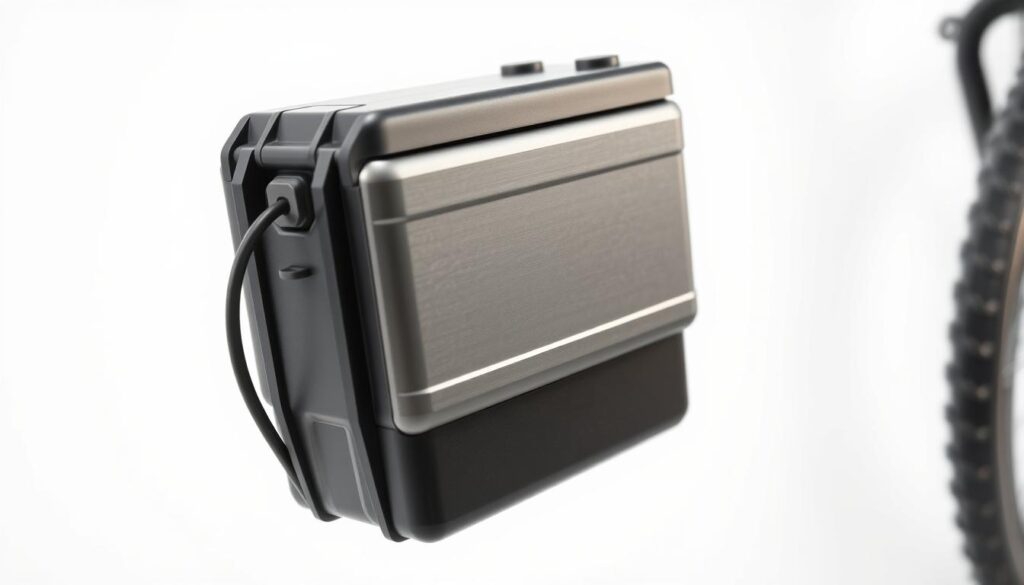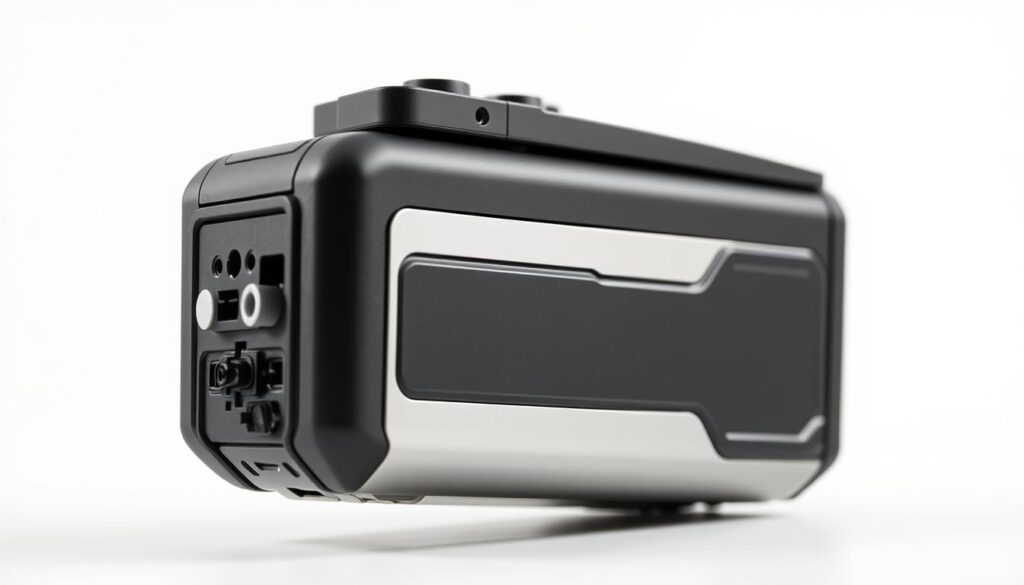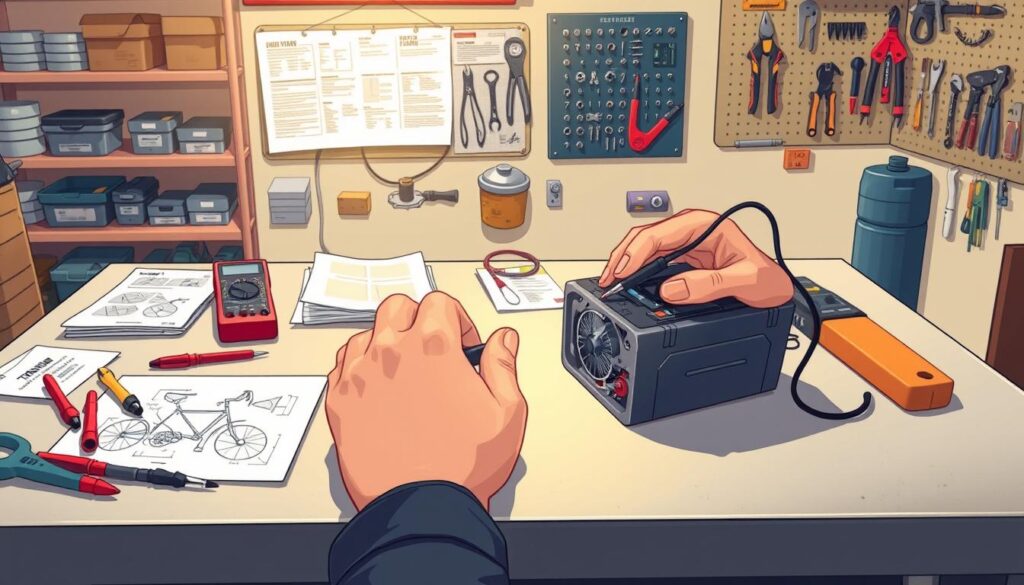E-bikes are becoming more popular, and knowing about E-bike Battery Issues is key. It helps keep your e-bike battery running well and lasts longer. With Ebikeranking, you can find top e-bikes and solve common issues.
Introduction to E-bike Battery Care
Knowing about batteries is important whether you’re new to e-bikes or have been riding for a while. Simple EV battery care tips can make your rides better and last longer. Follow these tips to keep your e-bike battery in top shape.

Table of Contents
Table of Contents
E-BikeYour E-bike Battery System
To fix e-bike troubleshooting problems, knowing your e-bike battery system is key. This knowledge helps spot e-bike battery issues and fix them. Your e-bike battery system has several parts, like battery cells, a battery management system, and a charging system.
Knowing how your e-bike battery should work is important. A good battery charges well, keeps its charge, and powers your e-bike steadily. But, if your battery’s range is short, charges slowly, or shows error messages, it might have a problem.

Types of E-bike Batteries
- Lead-acid batteries: These are cheap but heavy and not very efficient.
- Nickel-cadmium batteries: They perform better than lead-acid but cost more.
- Lithium-ion batteries: These are the most common, offering high efficiency, long life, and are light.
Basic Battery Components
The battery cells, management system, and charging system work together to power your e-bike. Knowing how they work can help you find and fix ebiketroubleshooting issues.
Common E-bike Battery Issues and Their Root Causes
Understanding the root causes of common e-bike battery issues is key. Many owners face problems like capacity loss, charging troubles, and system failures. To fix these, knowing the cause is vital. This can be due to wrong charging, deep discharging, or defects.
Spotting signs of trouble early is important. Look out for reduced range, charging issues, or system errors. Being proactive can help prevent problems and keep your battery healthy.
Some common issues and their causes are:
- Capacity loss: caused by deep discharging, improper charging, or aging
- Charging difficulties: caused by faulty charging ports, incorrect charging procedures, or battery management system failures
- Battery management system failures: caused by software glitches, hardware malfunctions, or manufacturing defects

Knowing the causes helps prevent E-bike Battery Issues. Regular care, correct charging, and quick action to problems can extend your battery’s life. This keeps your e-bike running smoothly.
Reduced Range and Performance Problems
As e-bike riders, we’ve all faced the problem of reduced range and performance issues. These problems can stem from many sources, like capacity loss, temperature changes, and bad charging habits. To resolve e-bike battery glitches and enjoy your ride more, it’s key to know the signs of capacity loss and how to fix them.
Common signs of capacity loss include less range, slow starts, and less power. If you’re seeing these signs, it’s time to check your e-bike battery maintenance tips and make some changes. For instance, try to charge your battery right, avoiding overcharging or undercharging to make it last longer.
To help with electric bike battery concerns, remember how temperature affects your battery’s range. Extreme temperatures can harm battery performance. So, it’s crucial to keep your battery safe from heat and cold. By following these tips and resolving e-bike battery glitches, you can extend your battery’s life and enjoy your e-bike more.
- Check your battery regularly for signs of wear and tear
- Adjust your charging habits to avoid overcharging or undercharging
- Protect your battery from extreme temperatures
By following these tips and keeping up with your e-bike battery maintenance tips, you can make sure your e-bike runs well. Always look after your battery’s health and take steps to help with electric bike battery concerns for a safe and fun ride.
Battery Charging Difficulties
Dealing with E-bike Battery Issues can be really tough, especially when charging is hard. This might happen due to bad charging systems, damaged batteries, or software problems. To fix these issues, knowing the causes and taking the right steps is key. This includes checking the charging system, updating software, or replacing broken parts.
Charging problems like slow charging, no charging, or error messages are common. Solving these e-bike battery errors is vital. By using a systematic approach to find and fix the problem, you can get back on your e-bike fast.
To avoid battery charging troubles, it’s important to charge your e-bike right and keep the battery in good shape. This means avoiding extreme temperatures, keeping the battery clean and dry, and updating your software often. These steps can help your e-bike battery last longer and prevent charging problems.
Here are some important steps to take if you’re having trouble charging your battery:
- Check the charging system for any damage or faults
- Update your software to the latest version
- Replace any faulty parts, like the battery or charging port
By following these steps and being proactive about e-bike battery care, you can avoid charging issues. This keeps your e-bike running well.
Temperature-Related Battery Concerns
Temperature is key for an e-bike battery’s performance and life. Extreme temps can cause E-bike Battery Issues, affecting the ebike’s efficiency. It’s important to know how temperature affects the battery and take care of it.
In cold weather, the battery’s chemical reactions slow down. This means less range and power. For ebike riders in cold, this is a big problem. High temperatures can also cause the battery to overheat, leading to damage and safety risks.
Cold Weather Effects
- Reduced range and power output
- Increased charging time
- Potential for battery damage if not properly maintained
Heat Management Solutions
To avoid overheating, some ebikes have cooling systems or software. These help keep the battery at the right temperature. Riders can also help by avoiding extreme temperatures and ensuring good air flow.
Optimal Storage Temperature
When storing an ebike, keep the battery at 50°F to 70°F (10°C to 21°C). This range is best for long-term storage. It keeps the battery healthy and prevents damage. By following these tips, riders can enjoy safe rides and take care of their ebikebattery.
Battery Management System(BMS) Failures
A faulty battery management system (BMS) is a big problem for E-bike Battery Issues. The BMS keeps an eye on the battery’s health, making sure it works right. But, if it fails, it can cause issues like less range and safety risks. Knowing how to fix these problems is key.
Understanding error codes is a big part of fixing e-bike issues. These codes tell you what’s wrong, helping you fix it. For example, a BMS error might show a problem with voltage or temperature. Knowing this lets you fix the issue and avoid more damage.
Common Error Codes and Solutions
- Low voltage error: Check the battery’s state of charge and ensure it’s properly connected to the e-bike.
- High temperature error: Ensure the battery is stored in a cool, dry place and avoid overcharging.
- Communication error: Check the connections between the BMS and the e-bike’s control system.
Knowing how to reset the system is also crucial. This can fix BMS problems and prevent more. By following these steps and keeping up with battery issues, your e-bike will run well. This keeps your e-bike in top shape and boosts your ebikeranking.
Preventive Maintenance Tips for E-bike Batteries
To fix e-bike battery issues and keep your electric bike running well, follow some easy e-bike battery maintenance tips. Regular charging, proper storage, and avoiding extreme temperatures are key. These steps help extend your e-bike battery’s life. By doing these, you can help with electric bike battery concerns and enjoy a smooth ride.
Here are some important tips to remember:
- Charge your battery regularly to keep it healthy
- Store your e-bike in a cool, dry place to avoid damage from extreme temperatures
- Check your battery’s state of charge, voltage, and capacity often to watch its health
Also, clean and check your battery and charging system often to avoid damage or corrosion. By sticking to these simple e-bike battery maintenance tips, you can fix e-bike battery issues and make sure your electric bike works great for years. If you have any electric bike battery concerns, don’t wait to get help with electric bike battery concerns from a pro.
When to Replace Your E-bike Battery
As an e-bike owner, knowing when to replace the battery is key. A battery nearing its end can lead to less range, slow charging, or error messages. In such cases, e-bike battery failure solutions can help find the problem. If the issue is with the battery, it might be time for a new one.
Getting a new e-bike battery is a big deal. The price varies based on the e-bike battery type and quality. You also need to think about installation costs and recycling fees for the old battery. Before deciding, E-bike Battery Issues,troubleshooting can help.
- Cost of a new battery
- Labor costs for installation
- Recycling options for the old battery
- Environmental impact of disposal
By considering these points and e-bike battery failure solutions, you can decide when to replace your battery. This ensures a safe and fun ride.
Professional vs. DIY Battery Solutions
Choosing between professional help and DIY solutions for e-bike battery issues can be tough. ebikeranking and ebiketroubleshooting skills are helpful but might not solve all problems. For complex issues, especially those involving warranties, getting professional help is best.
A pro has the right tools and knowledge to fix problems fast. But, for simple tasks, DIY can save money and be easier. It’s important to think about cost, safety, and the needed expertise before choosing.
Some key things to consider are:
- Cost: DIY is often cheaper but might not be the best choice for all problems.
- Expertise: Pros are trained to handle tough e-bike battery issues and offer top-notch ebiketroubleshooting services.
- Safety: Electrical work needs to be done safely, and pros can ensure this.
The choice between professional and DIY solutions depends on your skills, the problem’s complexity, and what you want to achieve. By considering these points, e-bike owners can make a smart choice and get back riding safely and quickly.
Safety Precautions for Battery Maintenance
When you’re working on your e-bike battery, safety comes first. It’s key to follow the right steps to avoid accidents. This way, your e-bike battery stays in top shape, giving you e-bike battery maintenance tips and help with electric bike battery concerns.
First off, handling your battery with care is crucial. This means avoiding short circuits and electrical shock. By doing this, you keep yourself safe and ensure the maintenance goes smoothly. Also, storing your batteries correctly is important. Keep them in a cool, dry spot, away from anything that could catch fire.
It’s also vital to have a plan for emergencies. Know what to do if your battery catches fire or explodes. Having the right tools and knowledge can help keep you and your bike safe. By being ready and following the right steps, you can keep your e-bike battery working well and enjoy your rides.
- Avoid overcharging or undercharging your battery
- Keep your battery away from flammable materials
- Follow proper storage procedures
By sticking to these safety tips, you can make sure your e-bike battery maintenance is safe and effective. Always put safety first and follow the right steps when working on your e-bike battery.
Maximizing Your E-bike Battery Life and Performance
To keep your e-bike battery working well, you need to take action. This guide shows you how to fix common E-bike Battery Issues and care for your battery. This way, you can enjoy your electric bike for many years.
Keeping your battery in good shape is key. This includes regular checks, correct charging, and knowing how your battery works. Always be careful with batteries and get help if you’re not sure about something.
By taking care of your e-bike battery, you make it last longer. This means you’ll have a better and safer ride. Keeping your battery in top shape also helps the environment, making electric bikes even more appealing.
FAQ
What should I do if my e-bike’s battery management system fails?
First, understand any error codes. Try resetting the system or updating the software. If problems continue, seek professional help.
What are the most common e-bike battery issues?
Common issues include reduced range and charging problems. Battery management system failures and temperature issues also occur. Lastly, batteries can degrade too quickly.
How can I troubleshoot reduced range and performance problems with my e-bike battery?
First, check for signs of capacity loss. Understand how temperature affects range. Lastly, optimize your charging habits to extend battery life.
What causes battery charging difficulties, and how can I resolve them?
Charging problems can stem from faulty systems, damaged batteries, or software issues. To fix these, inspect the charging system, update software, or replace faulty parts.
How does temperature affect e-bike battery performance, and how can I manage temperature-related concerns?
Extreme temperatures harm battery performance, reducing range and power. Use cooling systems and store batteries in ideal temperatures. Avoid extreme temperatures.








